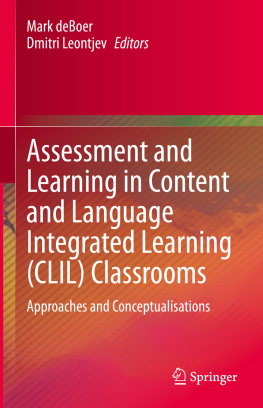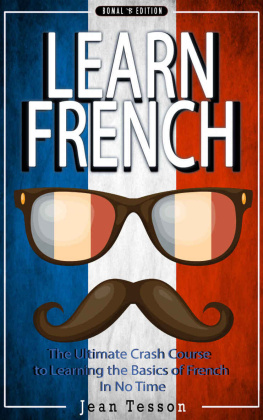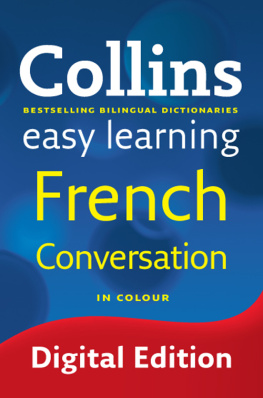Title Page
100+ FUN IDEAS FOR TEACHING FRENCH ACROSS THE CURRICULUM
in the Primary Classroom
Michelle Williams and Nicolette Hannam

Publisher Information
Written by Nicolette Hannam and Michelle Williams
Illustrated by Catherine Ward
Editorial, design and production by Bookcraft Ltd
Front cover illustration Kate Shannon
Cover designed by Brilliant Publications
Text Nicolette Hannam and Michelle Williams 2010
Design Brilliant Publications 2010
First printed and published in the UK in 2010
The right of Nicolette Hannam and Michelle Williams to be identified as the authors of this work has been asserted by themselves in accordance with the Copyright, Designs and Patents Act 1988.
All rights reserved. No part of this publication may be reproduced, stored in a retrieval system or transmitted in any form or by any means, electrical, mechanical, photocopying, recording or otherwise, without the prior written permission of the publisher.
Originally published by Brilliant Publications
Unit 10, Sparrow Hall Farm, Edlesborough, Dunstable, Bedfordshire, LU6 2ES, UK
Email:
Website: www.brilliantpublications.co.uk
Tel: 01525 222292
Digital version converted and published in 2011 by
Andrews UK Limited
www.andrewsuk.com
The name Brilliant Publications and the logo are registered trademarks.
Introduction
This book was written by Michelle Williams, a primary school teacher, and Nicolette Hannam, a secondary school teacher. While team-teaching French to Year 5 they looked at classroom displays, and began to see how easily French could be accommodated within normal lessons and embedded across the curriculum. This approach to language learning is known as Content Language Integrated Learning (CLIL).
The authors spent time examining the National Curriculum and identifying places where a link with French was possible. After much planning, teaching and evaluating they have now refined their ideas and collected them in this book, aimed at supporting schools that have chosen French as a modern foreign language for pupils throughout Key Stage 2.
How does CLIL work?
CLIL involves teaching a subject, such as history or maths, in the target language, where possible. It encourages a dual-language approach to any chosen topic, embedding the language within other subjects, and so enhancing pupils learning across the curriculum.
CLIL lessons can be stimulating and challenging. They are most successful when they are supported by visual aids, such as flashcards or dual-language interactive whiteboard presentations. Tasks should support pupils by reinforcing prior language knowledge and introducing new vocabulary gradually. These tasks often provide material for excellent creative displays that link work across the curriculum, helping pupils to retain information.
Why is CLIL beneficial?
The benefits of using a CLIL approach to lessons are many. Pupils can engage with a new language while also gaining knowledge in the target subject area. They are highly motivated by CLIL lessons, and enjoy this way of learning, as they are using their new language for a real purpose. Teachers have the opportunity to experience higher levels of job satisfaction, and develop innovative examples of good practice to share with other teachers.
CLIL lessons can further develop childrens cultural knowledge and understanding. They will improve childrens confidence in their language learning, and their communication skills.
Many teachers find the prospect of teaching French a little daunting and have visions of spending hours planning new and exciting lessons. But CLIL lessons make best use of curriculum time and give pupils extra time with their target language. Instead of competing for crucial teaching and learning time, CLIL allows French to complement other lessons. Over time a school will reap the rewards of using CLIL across the curriculum, and feel proud of the motivation and success of its learners.
Tips for introducing the teaching of French through CLIL
As with all new initiatives, introduce plans for CLIL teaching gradually.
Start by assessing teachers prior knowledge and levels of confidenceperhaps through a questionnaire.
Plan clear steps, and make sure these are communicated clearly to other teachers.
Make sure you provide a high level of support to staff.
Evaluate plans that have been put into practice and adapt future plans as appropriate, taking all opinions into account.
Offer to work with year groups to help identify places where French could be used to introduce and reinforce new subject knowledge; plan lessons together, ensuring coverage of the curriculum. Look on the Brilliant Publications website ( www.brilliantpublications.co.uk ) for charts showing how the activities in this book link to the National Curriculum.
Talk with other staff about how to support children who have difficulties.
Plan careful use of resources: which visual aids will be available, when, and to whom?
Discuss with other staff what expectations you all have about final outcomes of this way of teaching.
Model some CLIL teaching for other staff to watch.
Share successes with other staff.
Activities that work particularly well in a CLIL lesson
Making simple oral responses to key questions and statements. For example, ask children to respond to statements with either true or false (vrai or faux).
Ordering information: for example, putting in order pictures and sentences showing scenes from a play or fairytale.
Following simple instructions on a regular basis: for example, when warming up for PE.
Using Loop cards: children have a card showing both a question and an answer. One child starts by reading out their question, and the child with the answer on their card reads out the answer, then poses the next questionand so on.
Carrying out class surveys using questionnaires, the results to be recorded in French.
Playing guessing games, such as Twenty Questions. One child thinks of an object and the other children ask questions, trying to narrow down the possibilities until they can identify the mystery object.
Using CLIL alongside other French teaching
CLIL is an excellent way of engaging children and teachers, but it is not sufficient. Children will need access to dedicated French lessons when they focus specifically on French vocabulary and simple sentence structures. These lessons should be interspersed with regular CLIL lessons to further stimulate and enhance the childrens learning across the entire curriculum.
English
Speaking and listening skills feature in every French lesson as children read out loud, question each other, take on roles and discuss meanings of words. These skills can be successfully transferred to English lessons. Using French can reinforce understanding of the rules of English as children make crucial comparisons of language and spelling between the two languages.
Guided reading sessions can sometimes involve simple French texts, with children picking out key words. Ask children to find examples of questions, and identify the answers.
Writing can be modelled in French for the children to use as support. Punctuation can be reinforced whilst writing in French. Older children can be asked to punctuate a simple French text.
Speaking and listening
Speaking
1.Learning good habits
Tell children you are going to demonstrate both good and bad speaking habits. Do so, then discuss and clarify the differences.
Discussion topics: what happens if you dont look at the person you are speaking to? How does it make the other person feel? What is your body language saying? How should you react when someone doesnt look at you while talking to you?
Next page










